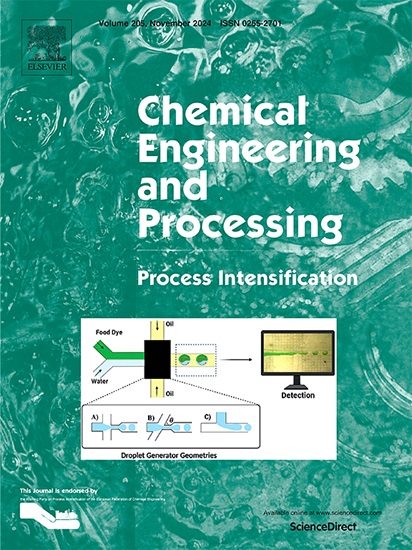Process development for biooxidation of refractory gold ore using Ferroplasma acidophilum: A bench-scale case study of gold recovery
IF 3.8
3区 工程技术
Q3 ENERGY & FUELS
Chemical Engineering and Processing - Process Intensification
Pub Date : 2025-06-05
DOI:10.1016/j.cep.2025.110377
引用次数: 0
Abstract
This study investigates the effects of biooxidation using Ferroplasma acidiphilum on gold recovery from high-grade (HGOS) and low-grade ore samples (LGOS). Pretreatment methods are caaried out in stirred tank reactors and column tests. Results showed that the stirred tank reactor yielded higher recovery rates for key elements, with gold recovery reaching 55 % for HGOS compared to 40 % for LGOS using the column test. Optimal conditions for biooxidation were identified, including aeration flow rates of 1.0–1.5 L/min and agitation speeds of 300–450 rpm, which facilitated effective microbial activity and pyrite dissolution. During cyanidation, gold recovery was highest at a pH of 10.5, with up to 60 % recovery at 8 (g/L) NaCN. However, at pH levels above 11, gold recovery decreased to around 40 % due to competing chemical species and metal hydroxide precipitation. The study also found that extending cyanidation time enhanced gold recovery, with significant increases observed within the first 10 h.

嗜酸铁等离子体生物氧化难处理金矿工艺研究:金矿回收的实验研究
研究了嗜酸铁原体生物氧化对高品位矿石(HGOS)和低品位矿石(LGOS)中金回收的影响。在搅拌槽式反应器和塔式试验中,提出了预处理方法。结果表明,搅拌槽反应器对关键元素的回收率较高,HGOS的金回收率达到55%,而LGOS的回收率为40%。确定了生物氧化的最佳条件,曝气流量为1.0 ~ 1.5 L/min,搅拌速度为300 ~ 450 rpm,有利于微生物活性和黄铁矿溶解。氰化过程中,在pH为10.5时金的回收率最高,在8 (g/L) NaCN时金的回收率可达60%。然而,当pH值高于11时,由于化学物质的竞争和金属氢氧化物的沉淀,金的回收率下降到40%左右。研究还发现,延长氰化时间可以提高金的回收率,在前10小时内观察到明显的提高。
本文章由计算机程序翻译,如有差异,请以英文原文为准。
求助全文
约1分钟内获得全文
求助全文
来源期刊
CiteScore
7.80
自引率
9.30%
发文量
408
审稿时长
49 days
期刊介绍:
Chemical Engineering and Processing: Process Intensification is intended for practicing researchers in industry and academia, working in the field of Process Engineering and related to the subject of Process Intensification.Articles published in the Journal demonstrate how novel discoveries, developments and theories in the field of Process Engineering and in particular Process Intensification may be used for analysis and design of innovative equipment and processing methods with substantially improved sustainability, efficiency and environmental performance.

 求助内容:
求助内容: 应助结果提醒方式:
应助结果提醒方式:


